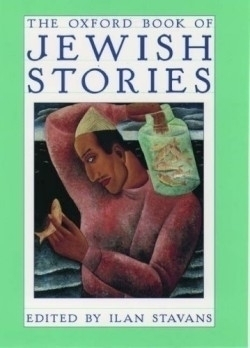The Oxford Book of Jewish Stories
Anthologies began as collections of poems, later including prose, the word itself coming to us from the Greek anthologos—flower-gathering—a collection of not necessarily the best known of a genre, but of literary efforts that a compiler feels compelled to bring together—an aesthetic offering.
“Choices, choices…” mutters Stavans, in his Preface to these 53 stories, originally written in a dozen languages. “To accommodate as many selections as possible, I aimed for stories with an average length of eight to ten pages…I sought writers engaged in deciphering their Jewish identity…stories of high artistic value that serve as mirrors to major transhistorical themes like anti-Semitism, assimilation, interreligious relations, mysticism, and the tension between politics and faith.” Stavans has chosen selections from authors who do not necessarily “address Jewish issues up front…is (Kafka) a Jewish author? Well, of course, in spite of the fact that nowhere in his fiction is the word ‘Jew’ ever inserted.”
The stories encompass a wide spectrum of worldwide Jewish writing from the mid-19th century to the present, a finely selected collection of variant voices, yet reflective of a common cultural heritage. Isaac Babel’s “The Story of My Dovecote,” is as reminiscent of a cultural milieu as is the Lithuanian Sholem Jacob Abramovitch’s “The Calf,” and Isaac Rosenfeld’s “The Hand That Fed Me,” a series of anguished letters revealing not only an unrequited passion, but an emptiness engulfing the protagonist’s mid-20th century life: “My whole life can be explained by hunger…”
The beauty of this collection is found in its far-reaching Diaspora—the underlying inherent connection of Jews everywhere and at any time. Thus from Italy, Primo Levi’s chilling “The Mirror Maker” and “The Art Biz,” from Allegre Goodman’s contemporary award-winning “The Family Markowitz” have an unspoken commonality of heritage that precedes and goes beyond nationality. On the same note it is easy to understand why Stavans, although seeking an arbitrary beginning date for inclusion, 1850, could not resist beginning with “The Rabbi’s Son,” a tale by one of the old Jewish mystics of the 18th century.
This is a rich readable gathering—brief tastes of treasures to be sought by seeking out the writings of the authors included, and specifically the books from which these stories have been invitingly plucked. Each story is preceded by a brief biographical sketch. A Chronology of Jewish Literature, 1667-1997 evinces a continuum of writing not defined by genre, but by a staunch surviving heritage.
Stavans, an Associate Professor of Spanish at Amherst College, evokes, through these selected stories, that a shared identity, centuries old, holds myriad possibilities in this expressing of it.
Disclosure: This article is not an endorsement, but a review. The publisher of this book provided free copies of the book to have their book reviewed by a professional reviewer. No fee was paid by the publisher for this review. Foreword Reviews only recommends books that we love. Foreword Magazine, Inc. is disclosing this in accordance with the Federal Trade Commission’s 16 CFR, Part 255.

